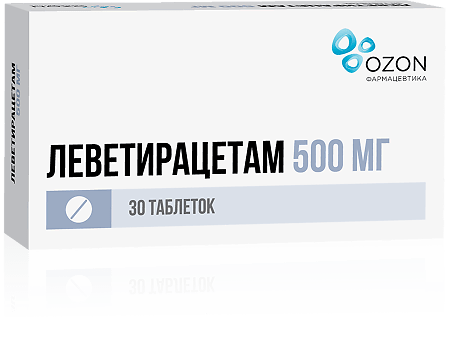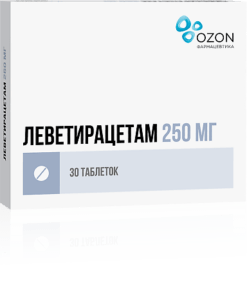No products in the cart.
Levetiracetam, 500 mg 30 pcs
€25.17 €21.82
Description
Levetiracetam
Indications
Indications
As monotherapy for the treatment of partial seizures with or without secondary generalization in patients over 16 years of age with newly diagnosed epilepsy.
As part of additional therapy in the treatment of: partial seizures with or without secondary generalization in patients older than 1 month (in the appropriate dosage form for children) with epilepsy; myoclonic convulsions in patients over 12 years of age with juvenile myoclonic epilepsy; primary generalized tonic-clonic seizures in patients over 12 years of age with idiopathic generalized epilepsy.
Pharmacological effect
Pharmacological effect
Pharmacotherapeutic group: Antiepileptic drug
Pharmacological action
Antiepileptic drug, pyrrolidone derivative (S-enantiomer of α-ethyl-2-oxo-1-pyrrolidine-acetamide). Its chemical structure differs from known antiepileptic drugs. The mechanism of action of levetiracetam is not fully understood, but it is obvious that it differs from the mechanism of action of known antiepileptic drugs.
In vitro and in vivo studies have shown that levetiracetam does not affect basic cell characteristics and normal neurotransmission.
In vitro and in vivo studies have shown that levetiracetam affects the intraneuronal concentration of Ca2+ ions, partially inhibiting Ca2+ current through N-type channels and reducing the release of calcium from intraneuronal stores. In addition, levetiracetam partially restores currents through GABA- and glycine-dependent channels reduced by zinc and β-carbolines. Also in in vitro studies, levetiracetam was determined to bind to a specific site in brain tissue. The binding site is synaptic vesicle protein 2A, which is thought to be involved in vesicle fusion and exocytosis of neurotransmitters. Levetiracetam and related analogues differ in their binding affinity to synaptic vesicle protein 2A, which correlates with the degree of antiepileptic protection in an audiogenic mouse model of epilepsy. This fact suggests that the interaction between levetiracetam and synaptic vesicle protein 2A apparently contributes to the anticonvulsant mechanism of action of the drug.
Levetiracetam induces antiepileptic protection in a variety of animal models of partial and primary generalized seizures without exhibiting proconvulsant effects. The main metabolite of levetiracetam is not active.
In humans, the activity of levetiracetam against epilepsy with both partial and generalized seizures (epileptiform discharges/photoparoxysmal reaction) supports its broad pharmacological profile.
Pharmacokinetics
Levetiracetam is a highly soluble substance with high penetrating ability. Levetiracetam has linear pharmacokinetics with low intra- and interindividual variability. The clearance of levetiracetam remains constant after repeated administration. The time-independent pharmacokinetic profile was also confirmed with intravenous administration of 1500 mg 2 times a day for 4 days. Cmax after a single intravenous injection of 1500 mg was achieved after 15 minutes and was 51±19 mcg/ml.
After oral administration, levetiracetam is well absorbed from the gastrointestinal tract. Absorption is complete and linear, so plasma concentrations can be predicted based on the administered dose of the drug in mg/kg body weight. The degree of absorption does not depend on the dose and time of food intake. Bioavailability is approximately 100%.
After taking a dose of 1 g, Cmax in blood plasma is reached after 1.3 hours and is 31 mcg/ml, after repeated dosing (2 times/day) – 43 mcg/ml.
Plasma protein binding of levetiracetam and its main metabolite is less than 10%. Vd of levetiracetam is about 0.5-0.7 l/kg. The equilibrium state is achieved after 2 days when taken 2 times a day.
Levetiracetam is inactively metabolized in the human body. The main metabolic pathway (24% of the dose) is enzymatic hydrolysis of the acetamide group. The formation of the primary pharmacologically inactive metabolite occurs without the participation of cytochrome P450 isoenzymes in the liver. Levetiracetam does not affect the enzymatic activity of hepatocytes.
In adults, T1/2 from blood plasma is 7±1 hours and does not change depending on the dose, route of administration or repeated administration. The average clearance is 0.96 ml/min/kg. 95% of the dose is excreted by the kidneys. The renal clearance of levetiracetam and its inactive metabolite is 0.6 ml/min/kg and 4.2 ml/min/kg, respectively.
In elderly patients, T1/2 increases by 40% and is 10-11 hours, which is associated with a decrease in renal function in this category of patients. In patients with impaired renal function, the clearance of levetiracetam and its primary metabolite correlates with CC. In end-stage renal failure in adult patients, T1/2 is 25 hours between dialysis sessions and 3.1 hours during dialysis. During a 4-hour dialysis session, up to 51% of levetiracetam is removed.
During the 4-hour dialysis process, 51% of levetiracetam is removed from the body.
In patients with mild to moderate liver dysfunction, there are no significant changes in the clearance of levetiracetam. In severe liver dysfunction with concomitant renal failure, the clearance of levetiracetam is reduced by more than 50%.
The pharmacokinetics of levetiracetam in children (aged 4 to 12 years) is linear in the dose range from 20 to 60 mg/kg/day. Cmax is reached after 0.5-1 hour. T1/2 in children after a single oral dose of 20 mg/kg body weight is 5-6 hours. The total clearance of levetiracetam in children is approximately 40% higher than in adults and is directly dependent on body weight.
Special instructions
Special instructions
For patients with kidney disease and decompensated liver disease, a kidney function test is recommended before starting treatment. If renal function is impaired, dose adjustment may be required.
In very rare cases, the use of levetiracetam was accompanied by acute kidney damage, developing from several days to several months.
Cases of decreased blood counts (neutropenia, agranulocytosis, leukopenia, thrombocytopenia and pancytopenia) have been described in association with the use of levetiracitam. A blood test with counting of formed elements is recommended for patients who experience severe weakness, hyperthermia, recurrent infections or blood clotting disorders.
During treatment with antiepileptic drugs, in particular levetiracetam, there have been reports of completed suicides, suicide attempts, and suicidal ideation and behavior. A meta-analysis of randomized, placebo-controlled trials of antiepileptic drugs found a small increase in the risk of suicidal ideation and behavior. The mechanism by which the risk increases is unknown. Therefore, during treatment with levetiracetam, signs of depression and/or suicidal ideation and behavior should be monitored and appropriate treatment provided if necessary. Patients (and their caregivers) should be advised that if signs of depression and/or suicidal ideation or behavior occur, they should seek medical attention.
Abnormal and aggressive behavior: Levetiracetam may cause psychotic symptoms and behavioral disturbances, including irritability and aggressiveness. Patients receiving levetiracetam should be monitored regularly for the development of certain psychiatric signs that indicate important changes in mood and/or personality. If such behavior is observed, potential adaptation to treatment or gradual discontinuation should be considered. If discontinuation of levetiracetam therapy is considered, the dose should be adjusted according to the recommended dosing regimen.
Increased severity of seizures: Like other antiepileptic drugs, levetiracetam may in rare cases increase the frequency or severity of seizures. This paradoxical effect was most often reported within the first month of levetiracetam initiation or dose increase and was reversible upon drug discontinuation or dose reduction. Patients should consult their physician immediately if the condition worsens.
ECG QT prolongation: Levetiracetam should be used with caution in patients with prolongation of the corrected QT interval or pre-existing cardiac disease, and concomitantly with drugs that affect the corrected QT interval.
Use in pediatrics
Available data on the use of levetiracetam in children indicate that this drug has no effect on growth and puberty. However, long-term effects on learning, intelligence, growth, endocrine function, puberty, and childbearing potential in children remain unknown.
Impact on the ability to drive vehicles and machinery
Levetiracetam has a minimal or moderate effect on the ability to drive vehicles and operate machinery. Due to possible differences in individual sensitivity, some patients may develop drowsiness or other central nervous system symptoms during treatment, especially at the beginning of treatment or after dose increases. Therefore, such patients are advised to exercise caution when performing tasks that require refined skills, such as driving or operating machinery. Patients should refrain from driving or operating machinery until they are confident that their ability to perform these tasks is not impaired.
Active ingredient
Active ingredient
Levetiracetam
Composition
Composition
Active substance: levetiracetam
Excipients: corn starch, croscarmellose sodium, povidone K25, colloidal silicon dioxide, magnesium stearate.
Pregnancy
Pregnancy
Adequate and strictly controlled clinical studies on the safety of levetiracetam in pregnant women have not been conducted, therefore levetiracetam should not be used during pregnancy unless absolutely necessary.
Physiological changes in a woman’s body during pregnancy may affect plasma concentrations of levetiracetam, as well as other antiepileptic drugs. During pregnancy, a decrease in plasma concentrations of levetiracetam was observed. This decrease is more pronounced in the first trimester (up to 60% of the baseline concentration in the period preceding pregnancy).
Treatment with levetiracetam in pregnant women should be carried out under special supervision. It should be borne in mind that interruptions in antiepileptic therapy can lead to a worsening of the disease, which is harmful for both the mother and the fetus.
Levetiracetam is excreted in breast milk, so breastfeeding is not recommended during treatment. However, if treatment with levetiracetam is necessary during lactation, the risk/benefit ratio of treatment should be carefully weighed against the importance of breastfeeding.
Contraindications
Contraindications
Hypersensitivity to levetiracetam or other pyrrolidone derivatives, children under 1 month of age.
With caution
Elderly patients (over 65 years old); liver diseases in the stage of decompensation; renal failure.
Side Effects
Side Effects
Infectious and parasitic diseases: very often – nasopharyngitis; rarely – infections.
From the blood and lymphatic system: infrequently – thrombocytopenia, leukopenia; rarely – agranulocytosis, pancytopenia, neutropenia.
From the immune system: rarely – drug allergy with eosinophilia and systemic manifestations (DRESS syndrome), hypersensitivity (including angioedema and anaphylaxis).
Metabolism: often – anorexia; infrequently – weight gain, weight loss; rarely – hyponatremia.
Mental disorders: often – depression, hostility/aggression, anxiety, insomnia, nervousness/irritability; uncommon – suicide attempts, suicidal intentions, psychotic disorders, behavioral disorders, hallucinations, anger, confusion, panic attacks, emotional lability, agitation; rarely – suicide, personality disorder, thinking disorder, delusion.
From the nervous system: very often – drowsiness, headache; often – convulsions, imbalance, dizziness, lethargy, tremor; uncommon – amnesia, memory impairment, incoordination/ataxia, paresthesia, decreased concentration; rarely – choreoathetosis, dyskinesia, hyperkinesia, gait disturbance, encephalopathy, aggravation of seizures.
From the organ of vision: infrequently – diplopia, blurred vision.
From the organ of hearing and labyrinthine disorders: often – vertigo.
Cardiac disorders: rarely – prolonged QT interval on ECG.
From the respiratory system: often – cough.
From the digestive system: often – abdominal pain, diarrhea, dyspepsia, vomiting, nausea; rarely – pancreatitis.
From the liver and biliary tract: infrequently – changes in liver function tests; rarely – liver failure, hepatitis.
From the kidneys and urinary tract: rarely – acute renal failure.
From the skin and subcutaneous tissues: often – rash; uncommon – alopecia, eczema, itching; rarely – toxic epidermal necrolysis, Stevens-Johnson syndrome, erythema multiforme.
From the musculoskeletal system: infrequently – muscle weakness, myalgia; rarely – rhabdomyolysis and increased CPK levels in the blood.
General disorders: often – asthenia/fatigue, trauma, intoxication and complications of manipulation; infrequently – accidental damage.
Interaction
Interaction
According to available data, the clearance of levetiracetam in children receiving treatment with anticonvulsants that are inducers of microsomal liver enzymes is 20% higher. No dose adjustment is required.
Probenecid, a tubular secretion blocker (500 mg 4 times a day), has been shown to inhibit the renal clearance of the main metabolite of levetiracetam, but not levetiracetam itself. However, the concentration of this metabolite remains low.
With the simultaneous use of levetiracetam and methotrexate, a decrease in the clearance of methotrexate was observed, leading to an increase in the concentration of methotrexate in the blood to potentially toxic levels or an extension of the period of maintenance of such concentration. Plasma levels of methotrexate and levetiracetam should be monitored in patients receiving both drugs.
Manufacturer
Manufacturer
Ozon, Russia
Additional information
| Manufacturer | Ozon, Russia |
|---|---|
| Medication form | pills |
| Brand | Ozon |
Other forms…
Related products
Buy Levetiracetam, 500 mg 30 pcs with delivery to USA, UK, Europe and over 120 other countries.













